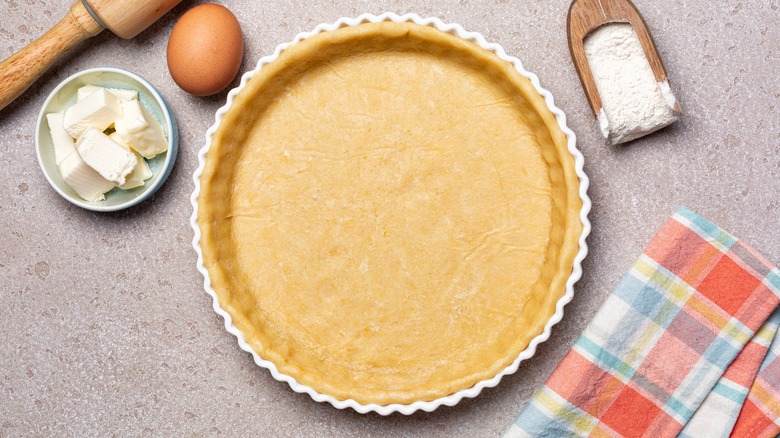Why Ree Drummond Adds Vinegar To Her Pie Crust
Tender and flaky pie crust is so much more than a vessel for delivering the filling — it should be just as delicious in its own right for the ultimate slice of pie. If you struggle to create a crust that's better than store-bought, Ree Drummond, Food Network television star and the writer behind the Pioneer Woman blog, suggests adding her secret ingredient of vinegar.
While Drummond may hate baking bread, she knows how to make a great pie crust. She recommends adding a splash of white vinegar to your dough (don't worry, it won't add a sour taste) and then freezing it before baking. The vinegar keeps the pie crust looking good by preventing discoloration, and popping it in the freezer creates a tender texture by allowing the dough's gluten to relax. Briefly-frozen pie crusts will also shrink less during baking. This makes for a better shape in the final baked good, an effect similar to chilling cookie dough.
If you're mixing up pie dough to use immediately, Drummond suggests putting it in the freezer for about 20 minutes before rolling it out. However, if you're freezing the dough for long term storage, you can either shape it into disks, wrap them plastic, and place them inside storage bags, or roll and shape them into disposable pie pans and freeze after covering in plastic wrap. Bake any frozen pie crusts (whether using vinegar or not) within three months for best results.
The Pioneer Woman's tips for perfect pie crust
Why does vinegar make for better pie crust? There is a baking myth that vinegar will inhibit gluten formation (and lead to a tender crust), but gluten formation actually increases in environments that are mildly acidic. Instead, vinegar makes for a dough that's easier to roll, with no cracking or overworking. Excessive kneading is a one-way ticket to a tough crust. Vinegar also stops the crust from oxidizing, which can make it turn gray, leaving you with a prettier pie in the end.
A general rule of thumb is to add 1 ½ teaspoons of vinegar per each batch of pie crust. Use subtle vinegar varieties like white or apple cider, and avoid overpowering versions such as balsamic. All out of vinegar? Swapping in equal parts lemon juice can also help improve your pie crust, since it provides acidity as well.
Ree Drummond's tips for pie crust go beyond vinegar and freezers. Your butter or fat needs to be cold while making the crust, but it benefits the finished product even more to keep your tools cool, such as by freezing your rolling pin. Drummond also recommends keeping cold water nearby to sprinkle over the dough if it seems dry, as this will create a smooth, perfectly chilled crust. Drummond adds that the best way to roll the dough is by placing your pin in the center and rolling it outwards. This creates an even thickness while not overworking it.


